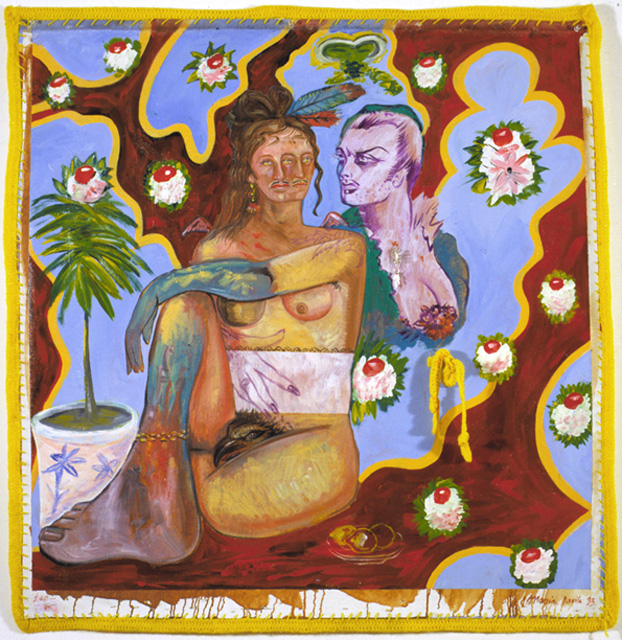


Since the early 1980s, Juan Davila's work has been at the forefront of debates about sexuality in art, censorship and identity politics. Davila is a Chilean who emigrated to Australia in 1974 after the fall of the socialist Allende government. A former law student, he is an artist of true intellectual sophistication who has published a number of seminal short articles, and is an incisive contributor to art forums.
Davila's hand-painted collages of found imagery have been drawn from a wide variety of sources: from superhero comics to the gay pornographer Tom of Finland, from Latin American popular votive imagery to the Antipodean paintings of Sidney Nolan. Other artists admire the technical mastery of his painting and the wit of his visual invention, even if his mordant social and cultural criticism makes them uncomfortable. The frankness of his imagery has not always been appreciated: issues of homosexuality and transvestism led, in the early 1980s, to his paintings being impounded by the New South Wales Vice Squad. A migrant who is now a naturalised Australian, Davila generated controversy in 2002 with an exhibition on the plight of refugees incarcerated in the Woomera detention centre.
The 1994 furore in international diplomacy provoked by his painting The liberator Simon Bolivar (1994) is testimony to Davila's unique ability to short-circuit the wiring of complacent cultural systems. The screenprint version held in the Vizard Foundation Collection, is a black-and-white revision of the source painting, which had been issued as a colour postcard in London by the Chilean Department of Education. Davila's presentation of the South American hero as a transsexual prostitute with just visible breasts and genitals led to vehement complaints by the governments of Venezuela, Colombia and Ecuador.1
The print reworks the postcard image in significant ways. The equestrian 'monument' is rendered in lustrous black ink and inventive plays with texture. Davila has used the white paper to make aureoles around Bolivar's head and his 'one-finger salute' to the public. He provides an 'Australian' background: a eucalypt replete with tree kangaroo, and the mounted figure of Nolan’s Ned Kelly. Australia is not exempt from the processes of memorialising and myth-making that Davila critiques in his Bolivar: Kelly, who has been promoted as a national hero by the likes of Nolan, sprouts breasts like the general's. The print symbolises Davila's 'perverse' and Latin American presence in the Australian cultural landscape.
Indigenous angel with Matisse background (1993) represents Davila's practice in assemblage-based installations, being the major element in a four-part wall and floor piece. At the time, Davila was exploring the aesthetics of patternisation and mural installation—issues integral to Matisse's work, but also to Davila's collaboration with Howard Arkley. Indigenous angel is a pastiche of Matisse's famous painting, Decorative figure on an ornamental background (1928).2 Davila gives an almost direct transcription of the whole, but subverts the aesthetics of Matisse's nude by turning the odalisque into a transsexual being. The woman's head takes on the mannish features of a South American peasant, with two noses and three eyes (following Picasso's cubist formula). Davila has moved aside Matisse's drape over the genitals to reveal the head of a beaked eagle, a surprisingly vicious aspect of the image. The bloated foot is one of those troubling images of bodily decay frequent in Davila's painting, but also evokes the outsize figures of the Latin American artist Fernando Botero. The picture was reused in an exhibition which satirised the touring Matisse retrospective in 1995.3
The large drawing, The pearl of the merchant (1997), exemplifies the 'hybrid' concerns of an émigré artist who is ambivalent about the Melbourne of the 1990s. The perverse ugliness of the seated figure, with her cartoon-character head and mutable gender, leads back to Davila's birthplace of Santiago. The pearl of the merchant is Davila's reworking of a third-rate Orientalist painting of that title held in Santiago's Fine Arts Museum, in which a cloaked Arab pulls a flimsy veil from the opulent female body representing his finest 'stock'. Here Davila replaces the odalisque with the lowbrow comic-strip character Verdejo, and substitutes the merchant with a svelte male figure borrowed from Otto Dix’s Portrait of Karl Krall (1923). Davila constricts the merchant's waist to give a feminine aspect, counterposing it with a massive hairy hand. Behind him is the Southbank complex on the Yarra river (the water and the 'blade' of the Melbourne Exhibition Centre are just visible). The exploding colours above represent the opening celebrations for the Crown Casino, held in 1997. The artist has tweaked the physiognomy of the balding merchant to emphasise a likeness with Lloyd Williams, the first proprietor of Crown.
Davila is unique in his fearless critique of Australian cultural politics. In this work he lampoons a community that spent billions on a gambling Mecca and a trickle on contemporary art; he dares point out links between major institutions like Crown and the National Gallery of Victoria, (the renovation of which was partly funded with casino profits). The artist has said, 'My criticism is to all state galleries and their emphasis on the "cockbuster" for the blue-rinse set, and their absolute refusal to discuss the social, political and cultural issues proposed by contemporary art in Australia'.4 In the final contradiction, he dares to bite the hand that feeds him.
- Roger Benjamin
Juan Davila is represented in Australia by Kalli Rolfe Contemporary Art, Melbourne.